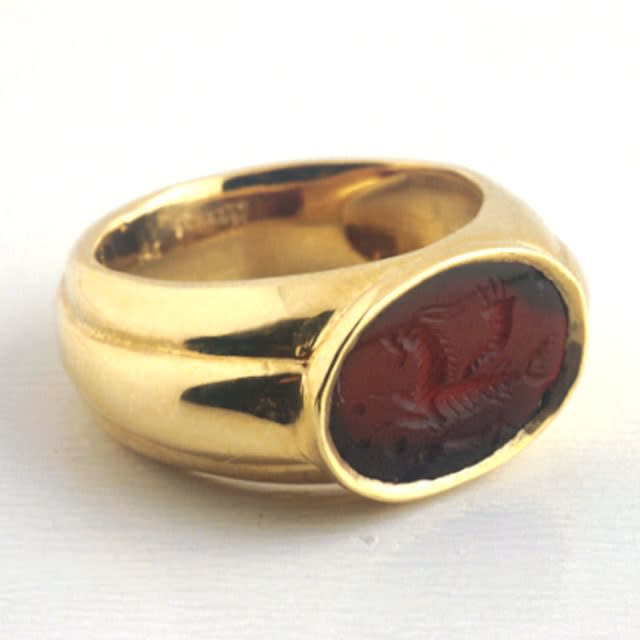Carnelian Roman Intaglio depicting a Sea Monster, 100 CE - 300 CE
Carnelian-Gold
FJ.6191
This intaglio is set in an 18 karat gold rin Intaglios were one of the earliest forms of the decorative arts, dating as early as the fourth and third millennia...
This intaglio is set in an 18 karat gold rin
Intaglios were one of the earliest forms of the decorative arts, dating as early as the fourth and third millennia BC in Mesopotamia and the Aegean Islands. The tools required for carving gems were simple: a wheel with a belt-drive and a set of drills. Abrasives were needed since the minerals used were too hard for a metal edge. In imperial Rome, members of the royal court and nobility often wore intaglios as seals or with the image of the emperor. Engravers often drew upon popular mythology as a suitable subject matter, and this very charming intaglio is a perfect example of this inventiveness. It shows a curious creature half-horse and half-fish, no doubt part of Poseidon’s vast underwater retinue. Underneath the sea monster is a very delicately carved dolphin; and above is a cornucopia or a horn like the ones Tritons (half-man, half-fish) were said to blow. This intaglio shows refinement and elegance; qualities shared by the person who chooses to wear such an unusual ring.
Intaglios were one of the earliest forms of the decorative arts, dating as early as the fourth and third millennia BC in Mesopotamia and the Aegean Islands. The tools required for carving gems were simple: a wheel with a belt-drive and a set of drills. Abrasives were needed since the minerals used were too hard for a metal edge. In imperial Rome, members of the royal court and nobility often wore intaglios as seals or with the image of the emperor. Engravers often drew upon popular mythology as a suitable subject matter, and this very charming intaglio is a perfect example of this inventiveness. It shows a curious creature half-horse and half-fish, no doubt part of Poseidon’s vast underwater retinue. Underneath the sea monster is a very delicately carved dolphin; and above is a cornucopia or a horn like the ones Tritons (half-man, half-fish) were said to blow. This intaglio shows refinement and elegance; qualities shared by the person who chooses to wear such an unusual ring.
